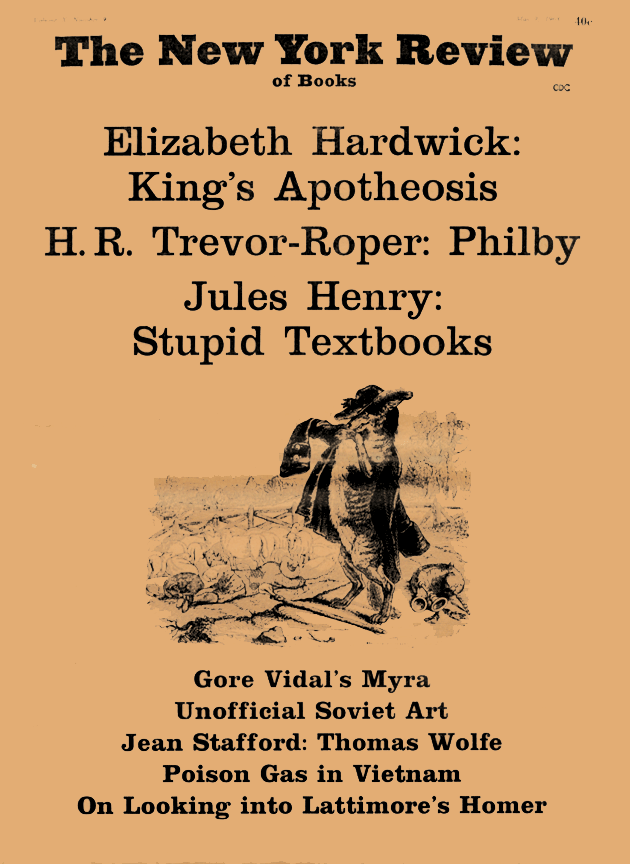Vidal said, “Let them be there!” And they were there. Tens of thousands of copies of Myra Breckinridge on bookstore tables across America. No free reviewer’s copies. No advance publicity. Just Gore Vidal’s underground novel selling and selling and selling. To my mother. To the movies. To me. Selling with such astonishing rapidity as to make the book’s publication itself a parody of things underground. A parody so successful that one begins to wonder if the underground still exists, and where.
In the dreary days of the Fifties, when the underground was still at the old location, two of its hippest sections were the Black and the Gay. Both were mysterious, initiatory, and glamorous in the way things are glamorous when they contain the potential for both excitement and danger. If one was not directly involved with either, but still curious, the key to Black was jazz, and to Gay those peculiar books one came upon from time to time.
Along with Isherwood, Vidal was the most agreeable of tourist guides, having early moved past the then current mode of writing about homosexual life either as poignant melodrama or as campy dream. His seventh novel, The Judgment of Paris, was one of the pleasures of 1952—a vastly entertaining view of the sweet dirty life in Europe after the war.
But times after taste, and fun is where you find it. The Black underground surfaced, the invisible man became visible—would not, in fact, go away. As for homosexuality, lately the word has the echo of old corridors. A college boy says, “Last night I dreamed that Donovan was my lover. Wild!” and does not expect to be thought queer, even in long hair and silver chains. It seems at times, these days, that everyone is everything. By contrast, homosexuality implies an almost puritanical rigidity.
For twenty-two years Vidal has skimmed lightly over the waves of modishness, bending fashion to his own use rather than being its creature. He has been a popular writer, yet, if he has not been considered exactly “literary,” neither has he been dismissed. It is something in itself to have remained fashionable for two decades. It suggests remarkable staying power. Now, walking on the waters of polymorphous perversity and sexual revolution, Vidal has written the first popular book of perverse pornography—a book for which one does not need even the slightest special taste. With Myra Breckinridge, his preoccupations seem to have entered the mainstream. Or the mainstream has enveloped them.
A rather slippery book, it begins as a quasi-inside joke about a formidable woman intellectual intoxicated by movie culture. Myra, the New Woman, is at work both on a scholarly book on Parker Tyler and the Films of the Forties (a section of which she has submitted to Partisan Review) and on her journal—a kind of anti-novel—which forms the substance of Vidal’s novel. She is, she writes of herself, “disturbingly beautiful” with “superbly shaped breasts reminiscent of those sported by Jean Harlow in Hell’s Angels and seen at their best four minutes after the start of the second reel.”
Having come to Hollywood to claim an inherited share in her uncle’s ghastly Academy of Dramatics and Modeling, Myra is also a pilgrim to the shrines of, as she notes in her journal: “blessed celluloid upon which have been imprinted in our century all the dreams and shadows that have haunted the human race since man’s harsh and turbulent origins (quote Lévi-Strauss).” Then, turning from the particular, Vidal slides into an elegantly nasty commentary on The Young, California, Popular Culture, Psychoanalytic Thought, Overpopulation, and Power. After which he gets down to the real business at hand, his vision of sexuality in America.
For those who do not already know, Myra is really Myron Breckinridge who has been operatively transformed into Myra and then—if imperfectly—back into Myron again; buggering and being buggered along the way, all events described in the luminous detail of the traditional pornographic novel—tea rose orifices, dildos, and so forth. But there is the strangest sense of displacement. If the quintessential dominant woman, all teeth and breast and muscle (resembling no one so much as Joan Crawford), bent on the final humiliation of the male is really a man who develops a taste for women—well, as the kids say, it messes up your head.
Vidal is always clever, and he has written a clever book. But since the audience for his rather insular satire must be limited, one can only assume that the popularity of the book is due largely to its hermaphroditic fantasies which apparently fascinate the average reader, than whom, as Myra says, there can be no fictional character more one-dimensional. This is not to equate Vidal with the semi-skilled laborers of the Bernard Geis establishment. Their books are manufactured and specious, constructed from materials which the publisher believes to be public obsessions. Vidal, on the other hand, has worked with the stuff of authentic obsession. As someone said, vouching for the authenticity of the fantasy, “There’s something so New Jersey about it. It’s the kind of thing we used to talk about back home on the block.”
Advertisement
While Myra Breckinridge is almost entirely a parody of present cultural attitudes and concerns, Vidal, at times, grows bored with his original conception of Myra as super-ridiculous and recreates her as a sort of wistful spokesman for his own best hopes. It is then that Vidal seems so charmingly innocent as he proselytizes for a future of pan-sexuality: Once man ceases to be confined to a single sexual role, his isolation will end.
Well, maybe. Or perhaps we are too much together, and the appeal of Myra Breckinridge is that it unwittingly invokes what might be the ultimate shared fantasy of the age—a future of androgynous independence: Sufficient unto the day is he who is sufficient unto himself.
This Issue
May 9, 1968


